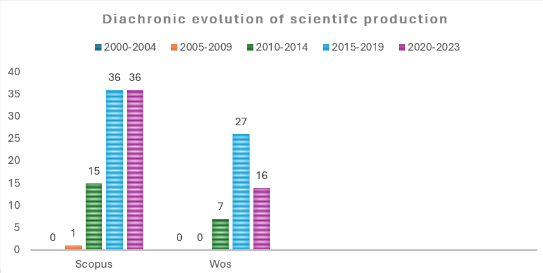Personalizing and decolonizing general education: A case study in gamifying global art history curriculum
Abstract
This study explores the transformation of general education art history courses at a liberal arts college, shifting from Eurocentric surveys to a decolonized, gamified, and student-centered curriculum. Through a longitudinal mixed-methods design, the research evaluates the integration of global narratives and innovative teaching strategies to enhance student engagement and global competencies. Data from pre- and post-implementation surveys with faculty, students, and instructional designers demonstrate significant improvements in student satisfaction, cultural openness, and engagement with global art. Challenges include navigating demographic skews, addressing the complexity of gamified structures, and refining assignment instructions. Findings highlight the value of curriculum redesigns that promote inclusivity, flexibility, and active learning, offering a framework for advancing general education in a globalized academic landscape.
References
[1]Howe WA, Lisi PL. Becoming a multicultural educator: Developing awareness, gaining skills, and taking action. Sage Publications; 2023.
[2]Mostafa T. Do all students have equal opportunities to learn global and intercultural skills at school?. PISA in Focus; 2020.
[3]Greener S. Cultural diversity and learning technology. Interactive Learning Environments. 2017; 25(8): 947-948. doi: 10.1080/10494820.2017.1384899
[4]Olt PA. Developing Social Empathy With Higher Education. The Proper Role of Higher Education in a Democratic Society; 2021.
[5]Chigbu BI, Ngwevu V, Jojo A. The effectiveness of innovative pedagogy in the industry 4.0: Educational ecosystem perspective. Social Sciences & Humanities Open. 2023; 7(1): 100419. doi: 10.1016/j.ssaho.2023.100419
[6]Chtena N. “Opening” Art History: Exploring the Motivations and Practices of Faculty using Open Educational Resources in Lower-Level and General Education Art History Courses. Journal of Interactive Media in Education. 2021; 2021(1). doi: 10.5334/jime.677
[7]Meijer WAJ. General education, cultural diversity, and identity. Studies in Philosophy and Education. 1996; 15(1-2): 113-120. doi: 10.1007/bf00367520
[8]Hutson J, Ceballos J. Rethinking Education in the Age of AI: The Importance of Developing Durable Skills in the Industry 4.0. Journal of Information Economics. 2023; 1(2): 26-35. doi: 10.58567/jie01020002
[9]Cempellin L. Preparing Our Students for the Professional World: Integrating Thematic Assignments and Teamwork into the Art History Survey Course Design. International Journal of Education & the Arts. 2024; 25(12).
[10]Neuwirth LS, Jović S, Mukherji BR. Reimagining higher education during and post-COVID-19: Challenges and opportunities. Journal of Adult and Continuing Education. 2020; 27(2): 141-156. doi: 10.1177/1477971420947738
[11]Lovano-Kerr J. Cultural diversity and art education: A global perspective. Journal of Cultural Research in Art Education. 1985; 3(1): 25.
[12]Freedman K, Hernández-Hernández F. Curriculum, Culture, and Art Education, 2nd ed. SUNY Press; 2024.
[13]Demeter M. Academic Knowledge Production and the Global South. Springer International Publishing; 2020.
[14]Zinn H, Macedo D. Howard Zinn on Democratic Education. Routledge; 2016.
[15]Dawson C. The making of Europe: An introduction to the history of European unity. CUA Press; 2002.
[16]Chalmers FG. Cultural colonialism and art education: Eurocentric and racist roots of art education. In: Art, culture, and pedagogy. Brill; 2019. pp. 37-46.
[17]Grant C, Price D. Decolonizing Art History. Art History. 2020; 43(1): 8-66. doi: 10.1111/1467-8365.12490
[18]Juneja M. Global art history and the ‘burden of representation’. In: Global Studies: Mapping Contemporary Art and Culture. Hatje Cantz; 2011.
[19]Verrall K. Beyond parochialism: Telling tales about black activism and conceptual art. Towards an African Canadian art history: Art, memory, and resistance; 2018.
[20]Jakubowska A, Radomska M. Horizontal Art History and Beyond. Routledge; 2022.
[21]Levitt P, Saferstein E, Jaber R, et al. Decolonizing Decoloniality: Decentering Art History and Comparative Literature Classrooms outside Europe and the United States. Comparative Education Review. 2023; 67(2): 277-297. doi: 10.1086/724062
[22]Shahjahan RA, Estera AL, Surla KL, et al. “Decolonizing” Curriculum and Pedagogy: A Comparative Review Across Disciplines and Global Higher Education Contexts. Review of Educational Research. 2021; 92(1): 73-113. doi: 10.3102/00346543211042423
[23]Bazett T, Clough CL. Course Coordination as an Avenue to Departmental Culture Change. PRIMUS. 2020; 31(3-5): 467-482. doi: 10.1080/10511970.2020.1793853
[24]Rodrigues L, Palomino PT, Toda AM, et al. Personalization Improves Gamification. In: Proceedings of the ACM on Human-Computer Interaction; September 2021; New York, NY, United States.
[25]Ullah MW, Murad MdW. Understanding the influences of ‘world culture course’ on students’ attitude and perception: An empirical study. The Journal of Developing Areas. 2016; 50(6): 245-259. doi: 10.1353/jda.2016.0128
[26]Higgins A, Maxwell A. Universal Design for Learning in the Geosciences for Access and Equity in Our Classrooms. Journal of Applied Instructional Design. 2021; 10(1). doi: 10.51869/101/aham
[27]Luo T, Hostetler K, Freeman C, et al. The power of open: benefits, barriers, and strategies for integration of open educational resources. Open Learning: The Journal of Open, Distance and e-Learning. 2019; 35(2): 140-158. doi: 10.1080/02680513.2019.1677222
[28]Iannella A, Marani S. Open Education Resources (OER) and Universal Design for Learning (UDL): A winning combination to enhance human diversity and uniqueness. In: Proceedings of the MOOCs, Language learning and mobility, design, integration, reuse; April 2021; Napoli, Italy.
[29]Verma RK, Gupta S, Illinich S. Technology-enhanced personalized learning in higher education. Advances in Technological Innovations in Higher Education; 2024.
[30]Bernacki ML, Greene MJ, Lobczowski NG. A Systematic Review of Research on Personalized Learning: Personalized by Whom, to What, How, and for What Purpose(s)? Educational Psychology Review. 2021; 33(4): 1675-1715. doi: 10.1007/s10648-021-09615-8
[31]Goldschmid B, Goldschmid ML. Individualizing instruction in higher education: A review. Higher Education. 1974; 3(1): 1-24. doi: 10.1007/bf00153989
[32]García-Peñalvo FJ, Rojas-López A. Personalized education for a programming course in higher education. IGI Global; 2019.
[33]Heywood J. Assessment in higher education. British Journal of Educational Studies. 1978; 26(3): 287.
[34]Oliveira W, Hamari J, Joaquim S, et al. The effects of personalized gamification on students’ flow experience, motivation, and enjoyment. Smart Learning Environments. 2022; 9(1). doi: 10.1186/s40561-022-00194-x
[35]Fletcher RB, Meyer LH, Anderson H, et al. Faculty and Students Conceptions of Assessment in Higher Education. Higher Education. 2011; 64(1): 119-133. doi: 10.1007/s10734-011-9484-1
[36]Hidayah A, Syahrani S. Internal Quality Assurance System Of Education In Financing Standards and Assessment Standards. Indonesian Journal of Education (INJOE). 2022; 3(2): 291-300. doi: 10.54443/injoe.v3i2.35
[37]Gallardo K. Competency-based assessment and the use of performance-based evaluation rubrics in higher education: Challenges towards the next decade. Problems of Education in the 21st Century. 2020; 78(1): 61-79. doi: 10.33225/pec/20.78.61
[38]Ifenthaler D, Schumacher C, Kuzilek J. Investigating students’ use of self‐assessments in higher education using learning analytics. Journal of Computer Assisted Learning. 2022; 39(1): 255-268. doi: 10.1111/jcal.12744
[39]Mikre F. Review Article: The roles of assessment in curriculum practice and enhancement of learning. Ethiopian Journal of Education and Sciences. 2011; 5(2). doi: 10.4314/ejesc.v5i2.65376
[40]Aristovnik A, Keržič D, Ravšelj D, et al. Impacts of the COVID-19 Pandemic on Life of Higher Education Students: A Global Perspective. Sustainability. 2020; 12(20): 8438. doi: 10.3390/su12208438
[41]Bond M, Bedenlier S, Marín VI, et al. Emergency remote teaching in higher education: mapping the first global online semester. International Journal of Educational Technology in Higher Education. 2021; 18(1). doi: 10.1186/s41239-021-00282-x
[42]Gauthier T. The value of microcredentials: The employer’s perspective. The Journal of Competency-Based Education. 2020; 5(2). doi: 10.1002/cbe2.1209
[43]Goss H. Student Learning Outcomes Assessment in Higher Education and in Academic Libraries: A Review of the Literature. The Journal of Academic Librarianship. 2022; 48(2): 102485. doi: 10.1016/j.acalib.2021.102485
[44]Tyler JH. The General Educational Development (GED) Credential: History, Current Research, and Directions for Policy and Practice. In: Review of Adult Learning and Literacy, Volume 5. Routledge; 2023.
[45]Crawford J, Cifuentes-Faura J. Sustainability in Higher Education during the COVID-19 Pandemic: A Systematic Review. Sustainability. 2022; 14(3): 1879. doi: 10.3390/su14031879
[46]Islam MdS, Stamp K. A reflection on future directions: Global international and intercultural competencies in higher education. Research in Comparative and International Education. 2020; 15(1): 69-75. doi: 10.1177/1745499920901951
[47]Guo-Brennan L. Making Virtual Global Learning Transformative and Inclusive: A Critical Reflective Study on High-Impact Practices in Higher Education. Journal of Teaching and Learning. 2022; 16(2): 28-49. doi: 10.22329/jtl.v16i2.6947
[48]Sandell EJ, Olson KA, Grigsby MRL. Intercultural Partnerships that Foster Cultural Competence. Elementary and Literacy Education Department Publications; 2021.
[49]Francisco JC. Student-Centric Perspectives of the ‘Why’ and ‘How’ of Fostering Global Competence in Education. Journal of Higher Education Theory and Practice. 2024; 24(3). doi: 10.33423/jhetp.v24i3.6834
[50]León N. Developing intercultural competence by participating in intensive intercultural service-learning. Michigan Journal of Community Service-Learning. 2014; 21: 17-30.
[51]Pryshliak O, Drapak H. Formation of value orientations of the personality of future specialists of socio-economic professions in the context of intercultural education. Uzhgorod: Uzhgorod National University. 2022; 1(50): 232-237.
[52]Onorati MG, d’Ovidio FD, Antonucci L. Cultural displacement as a lever to global-ready student profiles: results from a longitudinal study on International Lifelong Learning Programs (LLP). Quality & Quantity. 2016; 51(2): 545-563. doi: 10.1007/s11135-016-0424-0
[53]Karakose T. The impact of the COVID-19 epidemic on higher education: Opportunities and implications for policy and practice. Educational Process International Journal. 2021; 10(1). doi: 10.22521/edupij.2021.101.1
[54]Welsh JM. Disconnected, frustrated and withdrawn: institutional policy implications for equity in student and faculty community [PhD thesis]. University of South Dakota; 2023.
[55]Irwin B, Hepplestone S. Examining increased flexibility in assessment formats. Assessment & Evaluation in Higher Education. 2012; 37(7): 773-785. doi: 10.1080/02602938.2011.573842
[56]Pretorius L, Mourik G, Barratt C. Student choice and higher-order thinking: Using a novel flexible assessment regime combined with critical thinking activities to encourage the development of higher-order thinking. The International Journal of Teaching and Learning in Higher Education. 2017; 29(2): 389-401.
[57]Wanner T, Palmer E, Palmer D. Flexible assessment and student empowerment: advantages and disadvantages – research from an Australian university. Teaching in Higher Education. 2021; 29(2): 349-365. doi: 10.1080/13562517.2021.1989578
[58]Müller C, Stahl M, Alder M, et al. Learning Effectiveness and Students’ Perceptions in A Flexible Learning Course. European Journal of Open, Distance and E-Learning. 2018; 21(2): 44-52. doi: 10.2478/eurodl-2018-0006
[59]McGarry BJ, Theobald K, Lewis PA, et al. Flexible learning design in curriculum delivery promotes student engagement and develops metacognitive learners: An integrated review. Nurse Education Today. 2015; 35(9): 966-973. doi: 10.1016/j.nedt.2015.06.009
[60]Rideout CA. Students’ choices and achievement in large undergraduate classes using a novel flexible assessment approach. Assessment & Evaluation in Higher Education. 2017; 43(1): 68-78. doi: 10.1080/02602938.2017.1294144
[61]Galaige, Joy. Supporting Self-Regulated Learning with Student-Facing Learning Analytics: User-centric Design Guidelines. 2021.
[62]Sobral SR, Jesus-Silva N, Cardoso A, et al. EU27 Higher Education Institutions and COVID-19, Year 2020. International Journal of Environmental Research and Public Health. 2021; 18(11): 5963. doi: 10.3390/ijerph18115963
[63]Chingos MM, Griffiths RJ, Mulhern C, et al. Interactive Online Learning on Campus: Comparing Students’ Outcomes in Hybrid and Traditional Courses in the University System of Maryland. The Journal of Higher Education. 2016; 88(2): 210-233. doi: 10.1080/00221546.2016.1244409
[64]Duskaliyeva D, Kassymova G. Impact of hybrid education on students’ achievements in foreign language classrooms in the context of international studies (Russian). Педагогика и Методы Обучения. 2024; 66(1): 42-48. doi: 10.47344/sdu20bulletin.v66i1.1201
[65]Berns A, Isla-Montes JL, Palomo-Duarte M, et al. Motivation, students’ needs and learning outcomes: a hybrid game-based app for enhanced language learning. SpringerPlus. 2016; 5(1). doi: 10.1186/s40064-016-2971-1
[66]Artino AR. Online or face-to-face learning? Exploring the personal factors that predict students’ choice of instructional format. The Internet and Higher Education. 2010; 13(4): 272-276. doi: 10.1016/j.iheduc.2010.07.005
[67]Clayton K, Blumberg F, Auld DP. The relationship between motivation, learning strategies and choice of environment whether traditional or including an online component. British Journal of Educational Technology. 2010; 41(3): 349-364. doi: 10.1111/j.1467-8535.2009.00993.x
[68]Charytanowicz M, Zoła M, Suszyński W. The impact of the COVID-19 pandemic on higher education: Assessment of student performance in computer science. Mittal P, ed. PLOS ONE. 2024; 19(8): e0305763. doi: 10.1371/journal.pone.0305763
[69]Nortvig A, Petersen AK, Balle S. A literature review of the factors influencing e-learning and blended learning in relation to learning outcome, student satisfaction, and engagement. Electronic Journal of e-Learning. 2018; 16(1): 46-55.
[70]Murillo-Zamorano LR, López Sánchez JÁ, Godoy-Caballero AL, et al. Gamification and active learning in higher education: is it possible to match digital society, academia and students’ interests? International Journal of Educational Technology in Higher Education. 2021; 18(1). doi: 10.1186/s41239-021-00249-y
[71]Chung CH, Shen C, Qiu YZ. Students’ Acceptance of Gamification in Higher Education. International Journal of Game-Based Learning. 2019; 9(2): 1-19. doi: 10.4018/ijgbl.2019040101
[72]Mora A, Tondello GF, Nacke LE, et al. Effect of personalized gameful design on student engagement. 2018 IEEE Global Engineering Education Conference (EDUCON); 2018.
[73]Noran O. On gamification in action learning. In: Proceedings of the Australasian Computer Science Week Multiconference; 1-5 February 2016; Canberra Australia.
[74]Aljabali RN, Ahmad N. A Review on Adopting Personalized Gamified Experience in the Learning Context. 2018 IEEE Conference on e-Learning, e-Management and e-Services (IC3e); 2018.
[75]Deshmukh J. Speculations on the post-pandemic university campus – a global inquiry. Archnet-IJAR: International Journal of Architectural Research. 2021; 15(1): 131-147. doi: 10.1108/arch-10-2020-0245
[76]Jarrah HY, Bilal DA, Halim M, et al. The impact of storytelling and narrative variables on skill acquisition in gamified learning. International Journal of Data and Network Science. 2024; 8(2): 1161-1168. doi: 10.5267/j.ijdns.2023.11.018
[77]Trinidad M, Calderon A, Ruiz M. GoRace: A Multi-Context and Narrative-Based Gamification Suite to Overcome Gamification Technological Challenges. IEEE Access. 2021; 9: 65882-65905. doi: 10.1109/access.2021.3076291
[78]Clarke A, Sharp K, Tai M. Technology-enabled curriculum for transnational education in art history and theory. International Journal of Education and the Arts. 2017; 18: 1-20
[79]Zijlmans, K. Pushing back frontiers: Towards a history of art in a global perspective. International Journal of Anthropology. 2003; 18(4): 201-210. doi: 10.1007/bf02447905
[80]Chiem K, Colburn CS. Global Foundations for a World Art History. Visual Resources. 2015; 31(3-4): 177-199. doi: 10.1080/01973762.2015.1083675
[81]Meloche A, May T. Surveying the art history mystery: Student opinions of outcomes and value. Art, design & communication in higher education. 2022; 21(1): 43-65. doi: 10.1386/adch_00046_1
[82]Metcalfe AS. Visualizing the COVID-19 pandemic response in Canadian higher education: an extended photo essay. Studies in Higher Education. 2020; 46(1): 5-18. doi: 10.1080/03075079.2020.1843151
Copyright (c) 2025 Author(s)

This work is licensed under a Creative Commons Attribution 4.0 International License.









